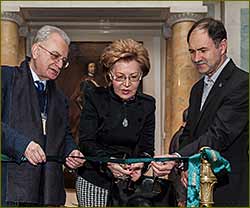02.12.2015 06:41

It was inaugurated by Mikhail B. Piotrovsky, Director of the State Hermitage Museum, and Vera A. Dementieva, Director of the Pavlovsk State Museum-Preserve. After the official opening, attending journalists could ask their questions of Victor A. Korobov, Head of the Laboratory for Scientific Restoration of Easel Painting and curator of the exhibition at the State Hermitage Museum, and of the Museum employees who participated in the restoration. Symbolically, the exhibition opened on the day of the 71st anniversary of the liberation of Pavlovsk from Nazi occupation.
During the reign of Paul I, the portrait was placed in the Small Room of the palace, where it hung for about 140 years until the beginning of the Great Patriotic War. The painting was not evacuated in time so it was discovered severely damaged only during the liberation of Pavlovsk in 1944: the canvas was cut out of the frame and torn in several places, the paint layer was peeling off. In the 1960’s, the portrait of Peter I returned to its historic place after S.I. Kogan and M.Z. Prokopchuk, restorers of the Pavlovsk Palace Museum, recovered its presentation appearance in a short time. Half a century later, the artistic painting was found in an emergency condition and in late 2011 the portrait was sent to the Laboratory for Scientific Restoration of Easel Painting of the State Hermitage Museum (art restorers V.Yu. Brovkin, V.A. Korobov, A.S. Nikolsky).
Restoration work consisted of three stages: conservation, discovery of the original painting under old multiple layers applied at different times, and artistic restoration, implying replenishing losses.
During the first stage of restoration associated with conservation of the painting, it became clear that the consequences of cutting and twisting it into a roll are not the only traces of vandalism caused to the portrait by war. A mirror inscription in German saying “Heil Wache” (which means “Long live the security man”) was found on the reverse side of the canvas, in the bottom right. Melted edges of the letters suggest that the inscription was burnt out by an incandescent awl or nail on the front side of the painting.
Upon completion of conservation in 2012, complex physical and chemical studies were carried out by S.V. Khavrin, an employee of the Department of Scientific and Technical Expertise at the State Hermitage Museum, and K.B. Kalinina, Candidate of Chemistry and art restorer of the Laboratory for Scientific Restoration of Easel Painting of the State Hermitage Museum. These studies not only allowed a better research of the technical and artistic features of the portrait of Peter the Great, but also confirmation of the authorship of Antoine Payen. It was found that the painting of total height of 255 cm consisted of the inner insert, i.e., the 78 63 cm high shoulder-length portrait of the Sovereign and the background. X-ray pattern of the main sections of the painting (face, both hands and the junction of the inserted canvas) confirmed the version of the researchers of the independence of the inserted portrait. Infrared photography provided complete information about the stages of creation of this piece of art. The creative endeavour of the artist is clearly visible in these photos, indicating that the idea of the whole composition of a large portrait belonged to Payen himself. The conducted comprehensive chemical analysis of the painting technique, binder and pigments showed that the portrait insert and the surrounding background were painted within a short timeframe in the same creative workshop. Discovery of the Prussian blue colourful pigment during the analysis is of great scientific interest as it confirms the theory about the use of this pigment long before 1724, when the formula for its production became public.
The restorers started the second work stage in late 2013 after conservation and regeneration (transparency recovery) of the varnish. Yellowed destructive varnish was removed from the painting keeping the entire layer painted by the author, as well as numerous restoring re-paintings that went widely beyond the author's painting, thus altering the original colouration. In the course of this work it became clear that there is no area of genuine painting left without significant intervention later on. No wonder the experts questioned whether the portrait was actually created by Payen.
Stages of the complex restoration, as well as physical and chemical studies conducted at the scientific laboratory of the State Hermitage Museum, suggest that today the Pavlovsk Palace Museum has a completely unique lifetime portrait of Peter I made by Antoine Payen, the famous European artist of the first half of the XVIII century.
A brochure was published for the exhibition.
Curators of the exhibition: the State Hermitage Museum is represented by Viktor A. Korobov, Head of the Laboratory for Scientific Restoration of Easel Painting; the Pavlovsk State Museum- Preserve is represented by Anna B. Nikiforova, senior researcher, custodian of the paintings’ collection.
News source: The State Hermitage Museum
 Print this news Print this news
Culture news archive for 12 February' 2015.
Culture news archive for February' 2015.
Culture news archive for 2015 year.
|